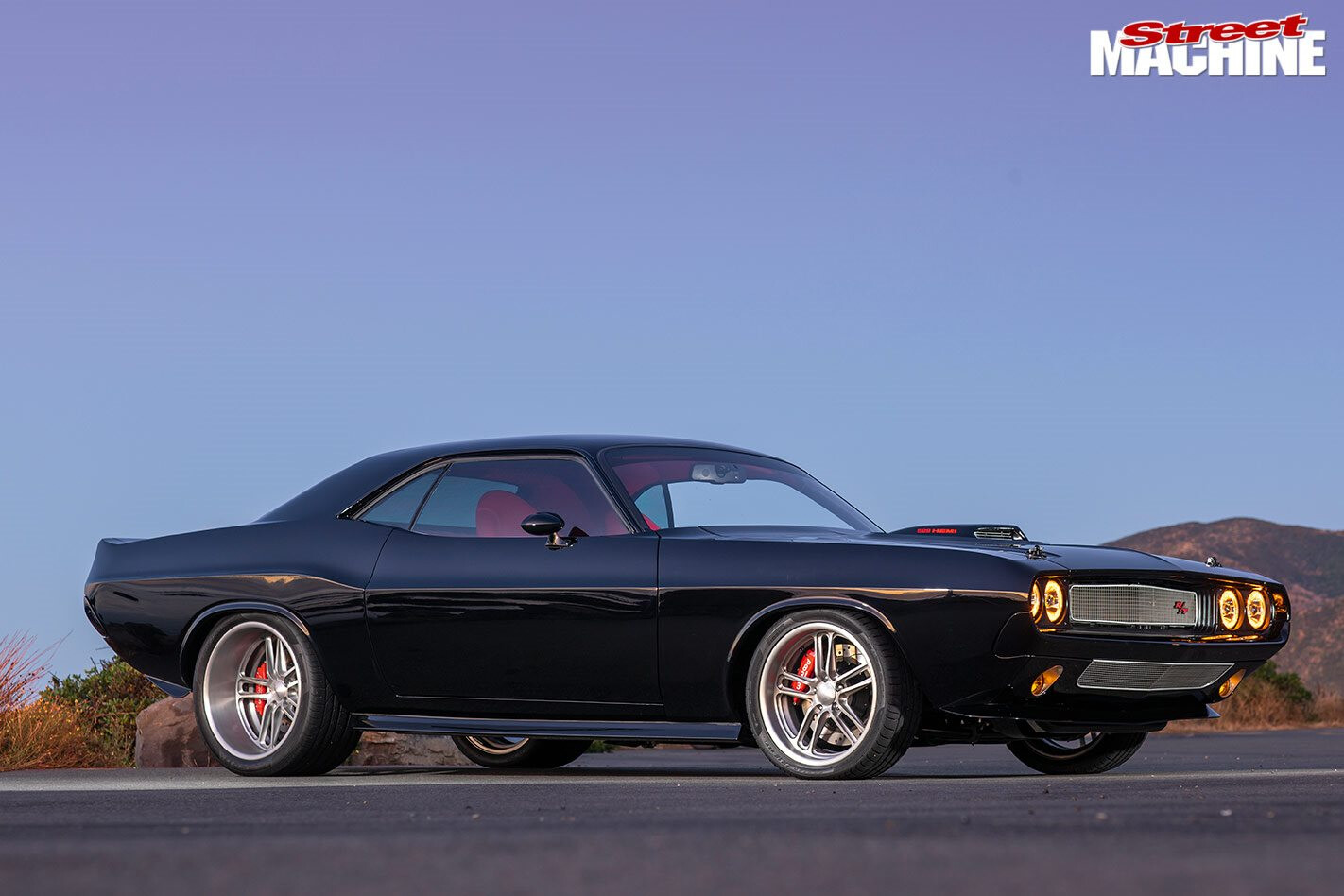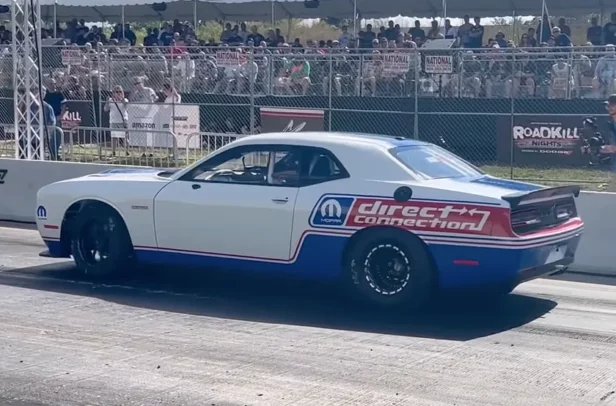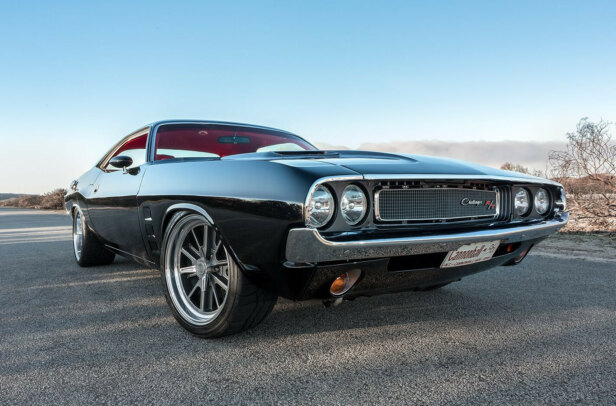PAUL Bailey has waited almost 30 years to build his dream car – a 1970 Dodge Challenger R/T – and as you can see from these photos, it proves that old saying that good things come to those who wait.
This article was first published in the July 2019 issue of Street Machine
It’s hard to improve on what many consider the best-looking muscle car ever made, but tucked-in bumpers, custom pans and smoothed flanks sure don’t hurt
“I had a little hot rod when I was 17 and sold it when I was 19, and then I bought a house and have been saving and saving for 28 years to do this,” says the New Zealander. “Instead of having a dozen cars and buying and selling them, I just wanted to have my dream car from the start.” Like many, his inspiration came from seeing Vanishing Point at the movies when he was just six years old.
Paul reckons it took him three or four years to decide on the wheels. He chose very wisely. The Budnik Pivots are not only handsome but lightweight
So, if you read between the lines, that means this is Paul’s first-ever modified car. In fact, it’s even his first V8, as that little hot rod was V6-powered. Talk about jumping in head-first from a great height!
In Paul’s defence, this project did take nine years to complete – which wasn’t actually part of the plan – but there’s a lot more to this car than initially meets the eye. That’s what happens when you spend some 2500 hours on metal fabrication and bodywork.
The rear bumper has been tucked in nice and tight and a T/A-style ducktail spoiler has been fabricated from steel
Being a joiner by trade, Paul farmed the work out to Timeless Auto Restorations, who then enlisted the expertise of Stacey Emeny at Mercury Garage to perform the long list of custom work that extends throughout the car.
It would probably be easier to mention the stuff that wasn’t changed, but I’ll give it a crack. The front and rear bumpers have both been tucked in nice and tight to the body, and custom pans were fabricated front and rear. The pans have also had openings worked into them, which then had mesh fitted to match up to the factory grille. Front and rear spoilers were also integrated into the bodywork, and all badges, handles and marker lights were removed for a super-smooth profile. Another very clever touch was the relocation of the fuel filler from the quarter panel to in between the tail-lights, where a custom HEMI badge was machined up and flips down to reveal the fuel cap. The rocker panels have also had side skirts worked into them, which extend to the rear quarter behind the wheels.
There’s more custom metalwork inside the car, with a completely custom-fabricated dashboard that houses a set of Auto Meter gauges in bespoke machined aluminium bezels. Each of the accessory gauge bezels is individually shaped to angle towards the driver. The door panels were also fabricated from steel to Paul’s design, and then it was all coated in satin black.
Keeping the driveline all Mopar, a narrowed Dana 60 diff is mounted on a Magnum Force four-link with a horizontal Watt’s link
The seats look like something pinched out of a late-model car, but they’re actually the originals that were stripped down to their frames and then reshaped to be much more curvaceous – and much more supportive when the road stops going in a straight line. They were then covered in bright red Monte Carlo leather. “It was going to be black on black,” Paul explains, “but then over the years I started looking at pictures of cars with red interiors and they looked quite classy, so that made me think of putting red pearl into the paint as well as painting the calipers red. Otherwise, it would have been a lot of black with nothing else, just a bit of aluminium. It keeps the missus a bit happier too; she wanted the car red.”
The boot is also fully trimmed out, and once again, all the painted surfaces are steel. The battery and stereo equipment is accessed through the removable panels
We still haven’t used up all of those 2500 hours, as there’s more custom metal fabrication in the engine bay, where the firewall and inner fenders were all custom-made, as was a filler panel to tidy up the front of the engine bay and cover up the radiator. There’s even more metalwork in the boot, where most people would simply use MDF, but as with the rest of the car, it’s all painted metal and red leather.
Why have 426 cubes when you can have 528 for not much more? Hiding under the shaker scoop are twin 550cfm Edelbrock carbs. Air conditioning, power steering, 625hp – this car has everything you need
Of course, all of this extra metal has added a fair bit of heft to the car and she probably weighs in around 1900-2000kg now, but there’s a solution for that, and it’s called horsepower! While the car would have been just fine with its matching-numbers 383 big-block, there’s really only one way to go with a Mopar, and that’s a Hemi, of course. “The original motor came in boxes, so it would have needed a new motor anyway, and I always wanted a Hemi so I looked into that. I discovered that for not much more money I could have a 528 instead of a 426,” Paul says.
The interior is fully customised, with the dashboard and door trims all shaped from metal. The front and rear seats are original, but have been heavily reworked and reshaped to a much more modern – and figure-hugging – profile. The red Monte Carlo leather is the kind of stuff you usually see on a Ferrari, while the Auto Meter gauges are housed in custom-machined bezels
The engine was built by Brad Harms Race Engines, and while Brad’s renowned for his drag-racing Hemis, this one was built with a more street-friendly outlook, although it’s got all the good gear. An Eagle eight-bolt crank and H-beam rods push around a set of Diamond forged pistons, while an HP Performance dual-quad intake mounts a couple of 550cfm Edelbrock carbs. There’s a Comp Cams hydraulic cam helping the fuel get in, and a set of Hooker headers make sure all the gasses get out as quick as they can. All up, the combination is good for 625hp and a block-of-flats-pulling 800lb-ft of torque at just 2200rpm!
While the engine may have been built by a drag racer, the rest of the car was built to stop, steer and handle the many bendy roads that NZ has to offer. Up front is a Hotchkis torsion-bar front end with improved upper A-arms and sway-bar, combined with Magnum Force two-inch dropped spindles to get the front down even lower. The rear end is more Magnum Force gear, a four-link with a horizontal Watt’s link and two-way adjustable Viking coil-overs.
The window washer bottle is topped up via this neat filler tucked into the dash, and is out of sight with the door shut. Clever!
Hauling it up are 14-inch Wilwood discs on all four corners that have been cross-drilled and slotted with six-spot calipers up front and four-spots on the rear. Of course, without decent rubber, none of that stuff matters, so Paul hasn’t skimped in that area either. There’s a set of Pirelli P-Zeros that measure up at 225/40R18 and 335/30R20 on a set of gorgeous Budnik Pivot wheels that are eight inches wide on the front and a meaty 13 inches wide on the back.
Paul had a mould taken off the original shifter, then cast in aluminium. He then sculpted it more to his liking. It sits in a custom-machined billet console that also houses the electric window switches
It’s definitely a car that was worth waiting for, and it’s won plenty of awards already, even making history by being the first street machine to be awarded the Sweepstakes winner at the NZ Hot Rod Nationals. The fact the car also won People’s Choice proves that Paul got it just right. Not a bad effort for his first modified car build!
PAUL BAILEY
1970 DODGE CHALLENGER R/T
Paint: PPG custom black with red pearl
DONK
Type: 528ci Hemi
Inlet: HP Performance dual-quad
Carb: Twin 550cfm Edelbrock Performer
Heads: Mopar Performance
Valves: 2.25in (in), 1.94in (ex)
Cam: Comp Cams hydraulic
Pistons: Diamond forged
Crank: Eagle eight-bolt
Conrods: Eagle H-beam
Radiator: Aluminium
Exhaust: Hooker headers, Flowmaster mufflers
Ignition: MSD
SHIFT
’Box: A-833 four-speed manual
Clutch: Powertrain hydraulic
Diff: Dana 60
BENEATH
Front end: Hotchkis torsion bar, Magnum Force 2in dropped spindles
Shocks: Viking
Steering: Power
Brakes: Wilwood 14in discs (f & r); six-spot calipers (f), four-spot calipers (r)
ROLLING STOCK
Rims: Budnik Pivot; 18×8 (f), 20×13 (r)
Rubber: Pirelli P-Zero; 225/40R18 (f), 335/30R20 (r)
THANKS
Steve Forrest at Xile Speed & Custom; Stacey Emeny at Mercury Garage; Mark Dunn at Kerry’s Upholstery; Kevin Redshaw at Timeless Auto Restoration




Comments